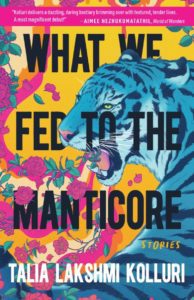It’s easy for us to move through our world with horse blinders on, going on about our everyday lives and falling into patterns of production and consumption, oftentimes to excess. Some of us are aware of this impact—both individual and collective—on our environment, and actively work to reduce the consequences, while others remain unaware at best, and, at worst, willingly exploit limited resources, and operate under the false belief that they can buy themselves out when harm comes their way.
Talia Lakshmi Kolluri gently takes those horse blinders off with her debut collection of short stories, What We Fed to the Manticore, out now from Tin House. In nine deeply tender stories, each voiced from the perspective of a different animal, Lakshmi Kolluri explores what lies in the overlap of tameness and wildness, and encourages us to extend empathy to the non-human creatures with whom we share our world. We meet a loyal donkey who moonlights as a zebra at the zoo his beloved owner recently opened in the middle of a combat zone. There’s the polar bear in search of food in a melting arctic. A wounded pigeon in Delhi finds a friend in a man devoted to her rehabilitation.
With lives as deep and complex as our own, the animals Lahskmi Kolluri gives voice to invite us to imagine what could be possible if we embraced the entanglement of our lives, and how, amidst the increasing threats to our natural world, we can protect them.
***
The Rumpus: What were some formative relationships you had with animals growing up?
Talia Lakshmi Kolluri: I had a lot of pets growing up. We had two cats, a dog, three parakeets (not all at once), and, at one point, I had pet crickets. I loved all of them the way a child loves their pets. Which is to say I did not fully conceive of them as distinct creatures with their own wants and emotions. I thought of them as soft, wonderful things that were there for the express purpose of being hugged by me. I also shared responsibility for taking care of them with my whole family. And looking back, I had the truly easy parts: filling food and water bowls, cleaning up after minor messes. It wasn’t until I had pets in adulthood that I really understood the selfhood of pets and what it means to care for another living thing completely, when it will never be possible to communicate with clarity. And it was these pets, and my relationships with them, that felt more formative than anything.
Rumpus: Was there an animal in particular that inspired you to explore this point of view in your writing?
Lakshmi Kolluri: I started with an interest in writing from various dog perspectives because I think they have proximity to humans in so many different capacities. I think I naturally gravitated toward dogs first as an easy entry point, although I don’t remember it being a conscious decision. After writing the first story (a previous version of “The Hunted, The Haunted, The Hungry, The Tame”), I very quickly pivoted to tigers. Once I felt that it was possible to write from an animal perspective, I ended up letting my own curiosity guide me.
Rumpus: What about tigers made you pivot so quickly?
Lakshmi Kolluri: I really wanted to write about a keystone species within an unstable ecosystem. I enjoy writing animals that have a close relationship to humans, and I’ve written several stories that way, but working animals and pets are always brought to the environment by the people they are attached to. They aren’t necessarily integrated into an environment the way a wild animal is. But an integrated animal that is vital to the health of its environment will be able to reveal the breakdown of that environment in a very personal way.
Tigers are a keystone species in many of the places where they live, including the Sundarbans. And even though tigers are glamorous apex predators, they are vulnerable to the larger threat of the climate crisis. In addition to poaching and prey depletion, tigers in coastal mangrove forests are threatened by things like saltwater intrusion, erosion, and cyclones. I knew early on that I wanted it to be clear that the suffering rendered by the climate crisis does not discriminate and is not reserved exclusively for creatures that we choose to designate as weak, fairly or not. And I felt that portraying the vulnerability of an animal we often view as fierce was really important.
Rumpus: Is there one story that spurred the entire collection, or did you want to write an entire collection from the animal perspective from the beginning?
Lakshmi Kolluri: The oldest story in the collection is “The Hunted, The Haunted, The Hungry, The Tame,” although I had written one prior story narrated from a dog point of view before. But I felt that “Hunted, Haunted” was the first time I had written an animal-narrated story that was close to what I had imagined. It felt successful in that sense and more importantly, I felt at home writing as an animal narrator. So I tried to write one or two more stories the same way and at that point I knew I would put together a collection. Truthfully, this style feels right to me and I expect I will continue until I get tired of it.
Rumpus: What about that story in particular solidified the sense of feeling at home writing from this perspective?
Lakshmi Kolluri: I ended up feeling very uninhibited. I think with human characters, and human narrators in particular, there is often this impulse to impute the opinions and characteristics of that narrator to the author. And when I’ve tried to write human narrators in the past, I ended up self-censoring a bit and the stories didn’t feel honest. But when I started writing in an animal voice, that issue completely evaporated for me, and I felt I could express far more as an animal than I felt I could as a human. I feel at home in all of my animal narrators, but when I wrote earlier versions of “The Hunted, The Haunted,” I wrote in a first-person voice as Bendiks and I just poured all of my own emotions, my own fears, and my own dreams into him. I didn’t worry about how he would be perceived at all, I just felt allowed to express myself however I wanted. And that feeling just grew every time I took on an animal voice.
Rumpus: There are nine stories, all narrated by different animals—from vultures to donkeys and whales. What drew you to these animals in particular?
Lakshmi Kolluri: I wanted to have a fairly broad spectrum of animal life because it was important to me to show the scope of human impact on the other creatures that we share our space with and their environments. I also wanted very much to explore different senses and to climb as far outside of myself as possible. Writing a whale’s soundscape or the experience of flying like a bird is the closest I will get to living as one of those animals, and I really wanted to know what those things felt like.
Rumpus: Are there any other animals whose heads you’d like to get into?
Lakshmi Kolluri: I would love to write something from the perspective of an octopus or some other kind of cephalopod. I suppose that would mean that I’m not getting inside their head so much as their arms. But I am very interested in trying to understand the thinking process of something with such a foreign anatomy. I have also wondered how it feels to be a jellyfish. I’ve been told they’re not very intelligent, but I can’t say if that’s true or not. What does it mean to be transparent? To be mostly water and almost one with your environment? Or what does it mean to have a phosphorescent glow? I really don’t know but I’d love to find out.
Rumpus: That is fascinating. Also, what is the barometer of intelligence here? Just because they can’t calculate a tip doesn’t mean they aren’t intelligent in other ways!
Lakshmi Kolluri: Exactly! I think we as a species are very narrow in our perception of what intelligence can be. I’ve been thinking lately about things like collective intelligence. Like with bees and the way they build honeycombs and hives. Or the man-o-war and how it lives as a colonial organism. And I wonder how the world is perceived by a collective. There’s a book coming out soon called How Far the Light Reaches by Sabrina Imbler, and I cannot wait to read it. It’s a book of essays about sea creatures woven through with stories about their own lives, and I’m looking forward to learning more about how the deep sea can upend our perceptions of what a life can look like.
Rumpus: There is one mythical animal that appears in the collection (and the title): the manticore. What made you decide to include a fictional creature, and why this specific one?
Lakshmi Kolluri: I chose the manticore because some research suggests that the mythical creature itself was inspired by a tiger. Its earliest mention in text is by a Greek historian named Ctesias in his fifth century BCE work Indica, which survives via fragments cited by others, including Pliny the Elder in his natural history. The mythology of a manticore is thought by others to have originated in Persia or India. It would make sense to me that if someone were seeing a tiger for the first time, they might interpret it as a fantastical beast. They are striking and spectacular! The Sundarbans itself is a striking ecosystem and has an astonishing amount of biodiversity which is magical. Also, in the Sundarbans, practitioners of almost every faith show special reverence to Dakshin Ray, the revered deity of the Sundarbans whose father was depicted as having tiger stripes and a long tail.
All this to say, a manticore does not seem out of place in this otherworldly landscape. I also wanted to introduce a force that is wholly out of the tigers’ control, that they cannot dominate, and that can explain something they do not truly understand, which is the storm. But I didn’t want that uncontrollable force to be an individual person. Since tigers are apex predators, I felt that something mythical was the natural choice.
Rumpus: Which story surprised you the most? (Whether it be an ending you were not originally writing towards, or an unexpected twist that revealed itself to you during the process?)
Lakshmi Kolluri: I was surprised most by “The Hunted, The Haunted, The Hungry, The Tame.” Or rather, I should say I was most surprised by my revision of that story. When it was first published in The Minnesota Review, it was written in the first person, and it was significantly more dreamlike, and kind of hallucinatory. My editor, the wonderful Elizabeth DeMeo, asked me to consider taking it in a different direction. In talking it through we realized that when I set a story in a cold climate, the tone becomes very hypnotic, as though I’m being lulled to sleep by what I’m imagining. So, I decided to change the point of view to third person.
In the intervening years between its first publication and my revision, I became a dedicated fan of Blair Braverman and Quince Mountain who are a writer/dog-musher couple, and I learned so much about sled-dogs and mushing by reading about their life with their dogs. This new knowledge and the changed point of view resulted in a much more richly rendered main character, and I was frankly surprised by how much personality he ended up having. He transformed from something abstract to something very alive, and I was truly sad that I had to stop spending time with him.
Rumpus: In your Author’s Note, you write, “If I were to set aside the traditional meanings of wildness and tameness and define them for myself, I would frame them in terms of dependence and communication.” Do you feel like wildness and tameness can exist side by side, that the overlap of the two may be the connective tissue that binds all living things, human and not?
Lakshmi Kolluri: Absolutely. I feel that I taste my own wildness the most when I have the chance to see a wild thing in its own environment, apparently unaware of me. Have you ever been near a body of water, at a shoreline or on a boat and you see a bird fly fast and low over the water just skimming it? When I see that, I feel this thrill, and the sense of some great possibility, and I can almost feel the air on me as though I have wings of my own and I too am flying fast and low over the water. That is the wildness in me, reminding me that the bird and I are one. We are made of the same basic molecules, breathing the same air, here together on the water, both of us animals.
Rumpus: By definition, “humanity” relates to all human beings collectively—the human race, humankind. But, after reading this collection, I feel like humanity may not be exclusive to humans, at least not all of the traits.
Lakshmi Kolluri: This is such an interesting point. As I was thinking about this, I looked up the formal definition of “humanity” and the first entry from Merriam-Webster is “compassionate, sympathetic, or generous behavior or disposition; the quality or state of being humane.” The second entry is “the quality or state of being human.” This is so odd to me because there is a lot of humanity (as we think of it) that is nowhere near being humane. I feel this very acutely at this exact point in history as I watch civil rights crumble, marginalized groups being aggressively persecuted, a staggering rise in economic inequality, food insecurity, and so many other things, all just laying bare the capacity of humans to be cruel to each other.
And then I think about wolves. First, I think about wolves and ravens who have a sort of cooperative relationship where ravens will sometimes lead wolves to potential prey and will then scavenge from the kill. They also have been observed engaging in play. And beyond providing a food source for ravens, wolves provide food to other animals that share their ecosystem because they never eat all of what they kill. And then I think about wolf pack structure and how the perception of a dominant “alpha” wolf is very outdated. In reality a wolf pack is led by a breeding pair—the alpha male and the alpha female—and the pack is composed of their pups, yearlings, and sometimes a parent who is no longer breeding. So essentially, they are a family group and they act cooperatively. Together, they raise the pups in their pack. They collaboratively hunt. They ensure each other’s survival and the thriving of the environment around them through this cooperative behavior. Is this compassionate or generous? It certainly can be interpreted that way. The wolves take what they need to ensure their survival, they cede what they don’t need to other animals.
Perhaps it’s not humanity that all of these other animals have because perhaps humanity is not the pinnacle of what a living thing can be. For a long time, we have framed ourselves as the highest order of life. We cast ourselves as the most intelligent. The worthiest of taking up space. And we treat the rest of all life as something to have dominion over instead of something we should care for. When we assign “humanity” or “personhood” to something non-human, we are often doing so as a way of assigning a higher value to that thing. Personhood and humanity often carry with them the suggestion that the thing they are granted to suddenly matters more than it used to. But a tree prior to and after its personhood is still the same tree and should matter the same amount. So, is it humanity that these animals demonstrate? Or is it that the thing that we believe defines and separates humans from other creatures has never really been exclusive to our species? I believe qualities like compassion and generosity are present in many other species and always have been. But perhaps we are now ready to see that.
Rumpus: Conversely, I feel like there are things that remain incomprehensible. And that’s just as important.
Lakshmi Kolluri: It is. I think sometimes that incomprehensibility can lead to reverence. And reverence for our environment as something sacred can be a way forward away from treating it exploitatively. What I fear is that if something is incomprehensible it is sometimes also treated as something to be feared or disregarded.
Rumpus: Who are some other writers you held near and dear—whether physically or in spirit—as you wrote this book?
Lakshmi Kolluri: There are so many writers of both fiction and non-fiction that I hold close as examples of writing about and through animals with sensitivity and nuance. But the person I would like to highlight is Jane Goodall. When I was a child, for a short time, my mother worked for the local public television station. They had all of these pledge gifts on hand and sometimes they would send things home with their employees. So, it was things like tote bags and 45s of Dr. Who and sweatshirts. One day she brought home this enormous hardcover by Jane Goodall called The Chimpanzees of Gombe: Patterns of Behavior, which I still have. It is not a book for children, and is a comprehensive account of twenty-five years of Dr. Goodall’s field of study and findings, clocking in at a hefty 655 pages of fine-printed text, diagrams, field photos, and citations. I was undeterred and it immediately became one of my favorite books.
The thing about Jane Goodall is that she was willing to look at things in a different way. In studying chimpanzees, she made an unorthodox and revolutionary decision to identify her study subjects by name instead of number, which was contrary to the standard practice of maintaining a sterile and objective distance from her subjects. I don’t know if naming them allowed her to think of them differently, or if she named them because she already thought of them differently than other scientists, but in any case, her work included a number of breakthroughs in chimpanzee research, including observing their use of tools. Tool use, social structure, emotional complexity among chimpanzees, and more, were all things that I learned at ten or eleven years old as I explored that book. It was as though the membrane between “human” and “animal” had thinned, become permeable, and then eventually wasn’t there at all.
I admire Jane Goodall a tremendous amount. For her intellect, for her courage in insisting on doing something new, and perhaps most of all, for her imagination which allowed her to see beyond the boundaries of the scientific practice around her. I hope these stories do justice to the spirit of compassion that her work inspired in me.
Rumpus: What kind of story (or stories) do you want to tell next?
Lakshmi Kolluri: I don’t feel finished with animal stories yet. There are so many more that I have yet to learn about, and I expect I will be writing along these same lines for a while. But in the immediate future I would like to explore stories that deal more directly with animal migration and animal captivity.
***
Author photo by Sarah Deragon






